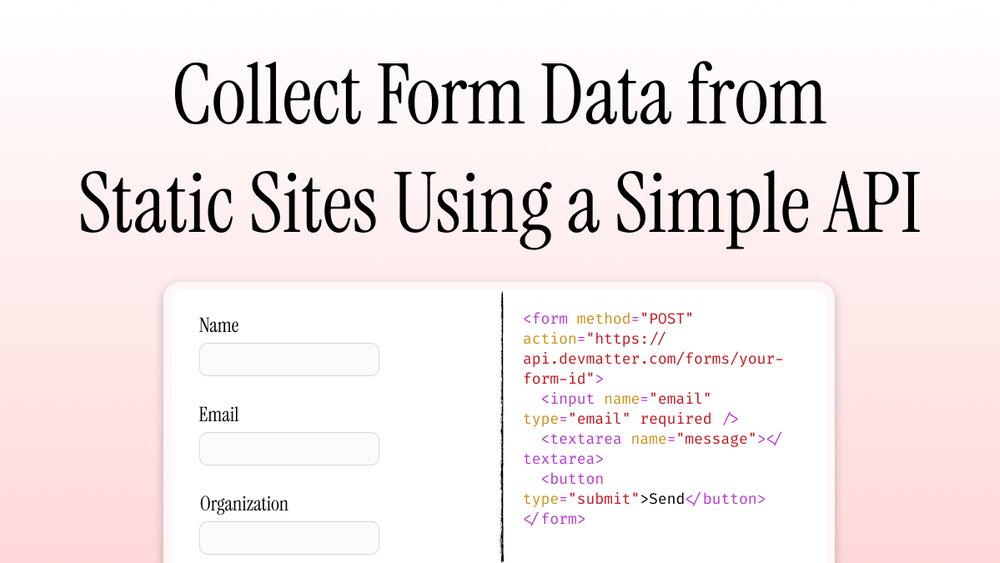Jul 8, 2025 • 3 min read
How to Collect Form Data from Static Sites Using a Simple API

Aditya
Founder

Static sites are fast, secure, and easy to deploy — but what do you do when you need to add a contact form, newsletter signup, or feedback form? Static sites don't have a backend, so handling form submissions can be tricky. That's where using a form backend for static sites comes in.
In this post, we'll walk through:
- Why forms on static sites are tricky
- When you do (or don't) need your own backend
- How to start simple with a form API for static sites
- How you can scale your logic later if needed
Why Forms Are a Challenge in Static Sites
Static sites are built with HTML, CSS, and JavaScript and served directly from a CDN or storage bucket. They load fast and are easy to host — but they don't have server-side code.
That means:
- You can't run code on form submissions
- You can't store data or send emails on your own
- You're stuck unless you connect the form to something external
Still, forms are critical for almost every website — whether it's for collecting leads, getting feedback, or supporting users.
What Are Your Options?
Here's how developers typically handle form submissions on static sites:
1. Use a Form API Backend
This is the easiest and most developer-friendly approach. You point your form to a hosted API that handles submissions for you — storing data, sending notifications, and optionally triggering integrations.
✅ Great for: no backend required, easy
setup
🚫 Limitations: can't run custom logic unless
the platform supports it
2. Build Your Own Backend
If you need more control, you can write your own API (e.g. with Node.js, Go, or serverless functions) to receive and process form data.
✅ Great for: advanced validation,
business logic
🚫 Takes time to build and maintain, and adds
complexity
3. Use Prebuilt Tools (Google Forms, Typeform, etc.)
These tools let you drop in a working form with zero code — but they can look out of place in your custom site, and you lose flexibility.
✅ Great for: fast internal forms
🚫 Not ideal for public-facing production
sites
Start Simple, Scale Later
You don't have to commit to a complex backend on day one. A smart approach is to start with a form API like DevMatter, then incrementally add features as your needs grow.
Here's how that can work:
1. Start with DevMatter
Add a form to your static site in minutes. No backend needed.
<form method="POST" action="https://api.devmatter.com/forms/your-form-id">
<input name="email" type="email" required />
<textarea name="message"></textarea>
<button type="submit">Send</button>
</form>
2. Later, add your own backend
If you want custom logic — say, spam filtering or rate limiting — you can point your form to your own backend, process the submission, and then forward it to DevMatter using their API. You get the best of both worlds.
3. Eventually, move everything in-house
If you outgrow the form API entirely, you can replace it piece by piece with your own logic. But many teams never need to.
This progressive model gives you speed now and flexibility later.
Common Use Cases
- Contact or inquiry forms
- Beta waitlists and lead collection
- Bug report or feedback forms
- Simple internal tools
Why DevMatter?
DevMatter is built for developers who want a form backend for static sites without the hassle. It gives you:
- A clean API endpoint to post to
- A dashboard to view submissions
- Webhooks, notifications, and integrations
- Zero backend setup
Whether you're building a landing page or a documentation site, DevMatter lets you go live quickly — and evolve your stack when you're ready.
Conclusion
Static sites are great — but forms don't work out of the box. Thankfully, you don't need to spin up your own backend just to collect a few fields. With a form API for static websites like DevMatter, you can start collecting data in minutes.
And if your needs grow? You can build on top of it — gradually adding validation, custom workflows, or your own APIs. You're never locked in.
Ready to start collecting form submissions from your static site?
Try DevMatter — the simplest form backend for
developers.
